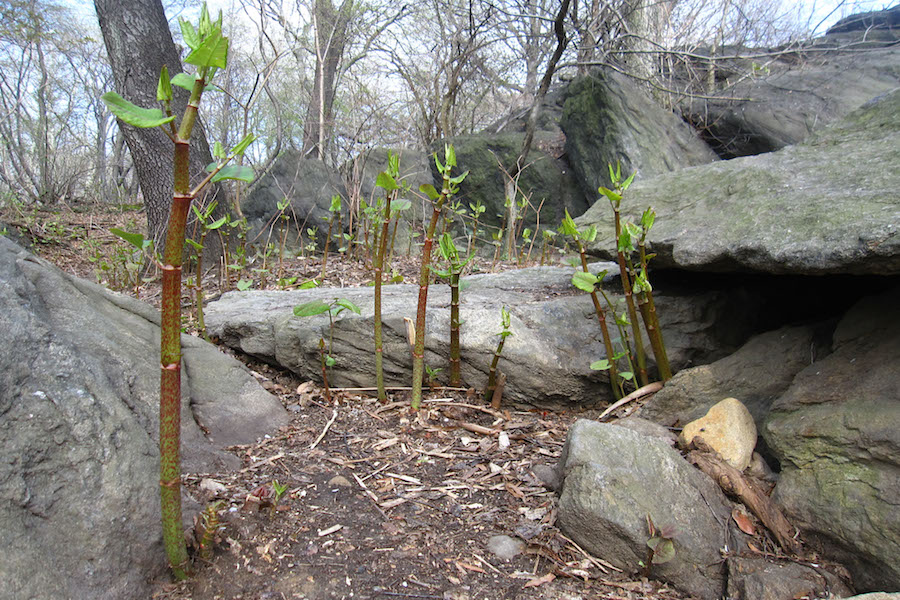In my foraging year, April scores big points. This is knotweed time.
Imported from the East in the late 18th century as a new ornamental, Polygonum cuspidatum (Fallopia japonica in the United Kingdom, a name I prefer) marched inexorably into our gardens, parks and wastelands and still shows no signs of leaving. Monsanto has dedicated an herbicide to it. Homeowners loathe it. The plant grows inches a day, and its hollow stems (fallopia, get it?) rocket from the ground to form by midsummer impenetrable thickets that crowd out more timorous native plants. Its rhizomes disturb underground pipes and foundations, and if you pull it out, it pops up somewhere else.
What few people realize is that this noxious weed is edible—and not merely edible, but delicious. In terms of texture and taste I’d put it alongside asparagus, rhubarb and sorrel: Highly seasonal, very flexible in application and one of the earliest vegetable pleasures of the year.
When I head hopefully into Central Park on an April morning, armed with paper shopping bags, it is with a mixture of skulking guilt and forager’s defiance. Guilt because we’re not supposed to remove plants from the park. Defiance because I am performing a service, gratis, by mowing down these promising fat shoots, preventing them from unfolding into branched eight-foot shrubs, from making flowers, setting seed and continuing their tramp across the ramble.
In one of my bags is a short-bladed knife. I wait for the day when my bag is searched on the subway. Uh, officer, yeah, the knife is for cutting knotweed? Silence. Just another New York weirdo. But well fed, officer.
In the park, my eyes scan the bare ground. A friend searched here a week ago and found nothing. Then I see them: fat, red-freckled stalks, some two feet high. From nothing to 14 inches in seven days? A weed that means business. And yet. This could be sold at farmers markets and fetch a pretty packet. I get down to business, slicing easily through the juicy stems at whose tips tiny green leaves have only just begun to unfurl. I swear my mouth begins to water. I gather two bagfuls and head, sated, back to Columbus Circle and the subway.
At home I sort the stems into like-size bundles, wash them in a deep basin of water and strip the young leaves from the stalk. These I steam separately or sauté simply with a dab of sweet butter and eat with salt and pepper and nothing more. Lemony, with a slight squeak. (Mature leaves contain higher levels of oxalic acid, as do spinach and sorrel, and are better avoided.)
But the stalks are the main event, and their applications seem endless. Perhaps it is because of their gently sour bite that I find them a serendipitous match for just about any dairy product out there—buttermilk, cream and cheese blend deliciously with the plant’s acid emphasis. The first dish must be fairly austere, to best enjoy exactly what one is eating. I blanch the stems, dust them with parmigiana and gratinate them under a blazing broiler. Black pepper. That’s all.
Then comes risotto, and after I have stirred finely sliced knotweed into the glistening rice I add what I seldom do: a third of a cup of cream. The requisite cheese again. This is fine dining. The knotweed has melted, its acid cutting seamlessly through the rich mound of rice on the fork.
Soup: knotweed in butter, cooked until tender, cooled and puréed with buttermilk or yogurt. Rich when hot and even better cold. Getting fancy: knotweed soufflé. The butter and flour roux. Milk, egg yolks, cheese (I prefer soft new goat). Knotweed first melted in butter and then stirred into the base mixture. Fluffy, whipped egg whites folded in, 12 minutes in the oven and a forager’s triumph: eating one’s knotweed soufflé, wondering why no one has figured out that this vegetable should be sold commercially.
It is used commercially for the manufacture of resveratrol supplements. Go figure. This tastes so much better. If you eat veal once this year, make a blanquette de veau au knotweed. Add the sliced stems when you add the cream. You won’t be sorry.
And hang in there for dessert. In simple syrup, cook a cup of knotweed sliced into pennies. Drain well. Purée. Make a thick custard with cream and egg yolks, stir in the knotweed and pour into custard cups. Caramelize sugar, pour it onto the chilled, set custard, and you have knotweed brûlée. I rest my case.



